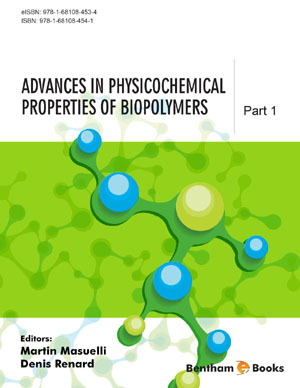Preface
Page: ii-ii (1)
Author: Meera Yadav and Hardeo Singh Yadav
DOI: 10.2174/9781681088471121010002
Scope and Importance of Biological Chemistry
Page: 1-32 (32)
Author: Nene Takio, Meera Yadav* and Hardeo Singh Yadav
DOI: 10.2174/9781681088471121010004
PDF Price: $30
Abstract
Biochemistry allows us to understand how various chemical processes in all living organisms interact and function to support life. It covers a wider range of scientific disciplines, which are sub-categorised into different branches. In this unit, the importance of biochemistry in medicine, health sectors, nutrition, and the living system has been discussed in detail. It also helps to understand biological phenomena of the environment and its conversation, genetic manipulations of genes via recombinant DNA technology and gene sequencing via human genome project. The knowledge of biochemistry has advanced tremendously and in forthcoming years, it has a potential role in unravelling the mystery of life processes.
Structure of Water: Acid-Base and Buffers; Hydrogen Bonding
Page: 33-56 (24)
Author: Nivedita Rai, Shilpa Saikia, Meera Yadav* and Hardeo Singh Yadav
DOI: 10.2174/9781681088471121010005
PDF Price: $30
Abstract
Water, being a universal solvent, makes up to 70% of the weight of living organisms. The amphoteric nature of water is explained by Lewis and Bronsted acidbase theory. Hydrogen bonding is crucial in many chemical processes. It is accountable for having water's unique solvent capabilityand also for hydrophobic effect. This chapter discusses in detail the hydrogen bonding between neighbouring water molecules and theirrole in physical and chemical changes in the water molecule. It also discusses the relationship between pressure and temperature in water via a phase diagram.
Electrostatic and Van Der Waals Forces
Page: 55-89 (35)
Author: Nene Takio, Dencil Basumatary, Meera Yadav* and Hardeo Singh Yadav
DOI: 10.2174/9781681088471121010006
PDF Price: $30
Abstract
Non-covalent intermolecular interactions are the fundamental forces which defines all the shape and structural stability of the biomolecules. Hydrogen bonds hold strands of DNA together and also responsible for determining the three-dimensional structure of folded proteins, whereas electrostatic and vander waals interactions are found to be a dominant factor in determining conformation of biomolecules. Noncovalent forces are individually weak relative to covalent bonds, but the cumulative effect of such interactions in a protein or nucleic acid can be very significant. They all play a fundamental role in fields as diverse as supramolecular chemistry, structural biology, polymer science and nanotechnology.
Introduction To Physical Techniques for Determination of Structure of Biopolymers
Page: 90-117 (28)
Author: Nene Takio, Meera Yadav* and SonamTashi Khom
DOI: 10.2174/9781681088471121010007
PDF Price: $30
Abstract
Biopolymers perform important cellular processes, which are isolated, purified and studied with the help of a wide range of biophysical, electrochemical and molecular biology techniques such as NMR, X-ray Crystallography, Electron Microscopy, and Electron Tomography. X-ray Crystallography helps us to establish 3D structures of small and large molecules at atomic resolution via the X-ray diffraction method, whereas NMR determines the content and purity of a sample. Electron microscopy obtains high-resolution images of biological and non-biological specimens and electron tomography provides three-dimensional density maps of the pleomorphic organism from macromolecular complexes to cells.
All these techniques, discussed in this unit, provide us a greater insight to unravel the mystery of complex organisms and to understand the structure and functional properties of the biomolecules.
Structure and Function of Biological Biomolecules: Carbohydrates, Amino Acids, Proteins, Nucleic Acids, Lipids and Biomembranes
Page: 118-213 (96)
Author: Nagendra Nath Yadav*, Saroj Yadav and Archana Pareek
DOI: 10.2174/9781681088471121010008
PDF Price: $30
Abstract
This chapter deals with the introduction, definition and classification of various biological molecules like carbohydrates, lipids and bio-membranes, amino acids, proteins and nucleic acids. The synthesis of carbohydrates, structure and function of monosaccharides, disaccharides and polysaccharides, absolute and relative configuration of sugar, reducing and non-reducing sugar, Fischer projection formula and Haworth projection formula are also briefly described. A brief knowledge about the type of fatty acids, acid value, soap value, various types of lipids, including phospholipids and sphingolipids, is also included. This unit also discusses the properties of various types of amino acids, proteins and nucleic acids, including structures of nucleoside, nucleotides, DNA and RNA.
Structure and Biological Function of Vitamins
Page: 214-260 (47)
Author: Nagendra Nath Yadav, Archana Pareek* and Sonam Tashi Khom
DOI: 10.2174/9781681088471121010009
PDF Price: $30
Abstract
This chapter deals with the introduction, classification and biological functions of vitamins. The deficiencies caused by water-insoluble vitamins such as vitamin-A, vitamin-D, vitamin-E and vitamin-K and water-soluble vitamins such as vitamin-C and the vitamin-B complex have been discussed in detail. The structure and properties of various types of vitamins are also part of this subject.
Enzymes (Biocatalyst)
Page: 261-284 (24)
Author: Nagendra Nath Yadav*, Archana Pareek and Kamlesh Singh Yadav
DOI: 10.2174/9781681088471121010010
PDF Price: $30
Abstract
In this chapter, brief accounts for the classification, nomenclature, and physiochemical nature of enzymes have been discussed. This chapter also deals with the action mechanism of an enzyme, enzyme kinetics, and factor affecting enzyme activity. A brief discussion about coenzymes, cofactors, and their role in biological systems has been addressed in this chapter.
Hormones
Page: 285-322 (38)
Author: Nagendra Nath Yadav* and Archana Pareek
DOI: 10.2174/9781681088471121010011
PDF Price: $30
Abstract
This chapter includes an introduction, classification, and type of hormones, as well as their biological functions. This chapter also gives a brief discussion about the structure, properties, and regulatory action of hormones. Various plant hormones and their functions have been discussed in this chapter.
Fundamentals of Thermodynamics: Principle Applicable To Biological Processes
Page: 323-360 (38)
Author: Nene Takio*, Pratibha Yadav and Anindita Hazarika
DOI: 10.2174/9781681088471121010012
PDF Price: $30
Abstract
All living organisms require energy from the surrounding and utilized by biomolecules that mediates the flow of energy from exergonic reactions to the energy requiring processes of life. This unit deals with the energy behind life in the form of three laws of thermodynamics. Derived the mathematical equations for the laws. Comparison of thermodynamic parameters like ΔH or ΔS and ΔG have been done to provide meaning ful insights about a process and its use in calculating the relative contributions of molecular phenomena to an overall process.
Bioenergetics, Metabolism of Biomolecules, Photosynthesis and Respiration, Transcription and Translation, Recombinant DNA Technology
Page: 361-410 (50)
Author: Saroj Yadav*, Kamlesh Singh Yadav and Pratibha Yadav
DOI: 10.2174/9781681088471121010013
PDF Price: $30
Abstract
This unit describes how living organisms are procuring their life with energy transform in order to perform biological work. This chapter explores the in-depth metabolism of carbohydrates, lipids and fats, proteins, nucleic acids and nucleotides. The relationship between photosynthesis and cellular respiration, the structure of DNA and the technology of recombinant DNA have been described in detail.
Introduction
Biochemistry: Fundamentals and Bioenergetics presents information about the basic and applied aspects of the chemistry of living organisms. The textbook covers the scope and importance of biochemistry, the latest physical techniques to determine biomolecular structure, detailed classification, structure and function of biomolecules such as carbohydrates, lipids, amino acids, proteins, nucleic acids, vitamins, enzymes and hormones. Readers will also learn about processes central to energy metabolism including photosynthesis and respiration, oxidative phosphorylation, DNA replication, transcription and translation, recombinant DNA technology. Key Features - logical approach to biochemistry with several examples - 10 organized chapters on biochemistry fundamentals and metabolism - focus on biomolecules and biochemical processes - references for further reading

















